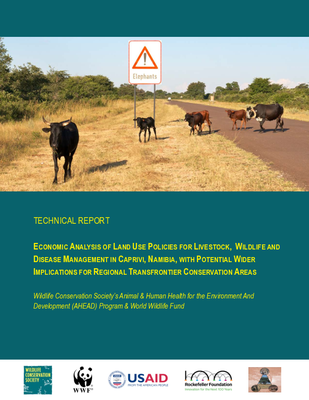Economic Analysis of Land Use Policies For Livestock, Wildlife and Disease Management In Caprivi, Namibia, With Potential Wider Implications For Regional Transfrontier Conservation Areas
Standard cost-benefit analysis was applied to several future policy options for land use and animal disease management in Caprivi, Namibia. Emphasis was placed on the livestock-wildlife interface and Caprivi’s role as central to the Kavango Zambezi (KAZA) transfrontier conservation area (TFCA). Empirically-based enterprise models measuring private and economic values for livestock and wildlife sectors in Caprivi were used to measure returns to investment for policy options regarding animal disease management and land use allocation. Options included commodity-based trade (CBT) and veterinary control fencing approaches to animal disease management. CBT is a production and marketing approach, which assures product safety regardless of the disease status of the area of origin and therefore permits adaptation of conventional (geographically-based) animal disease control measures. The basic measure of economic efficiency was incremental change in net national income at opportunity cost. Local livelihood contributions were also measured.
https://biodiversitylinks.org/library/resources/rmp/groups/cbrlm/cbrlm-for-review/economic-analysis-land-use-livestock-wildlife-disease-management-caprivi-namibia/view
https://biodiversitylinks.org/library/resources/rmp/groups/cbrlm/cbrlm-for-review/economic-analysis-land-use-livestock-wildlife-disease-management-caprivi-namibia/@@download/image/image.png
File
Economic Analysis of Land Use Policies For Livestock, Wildlife and Disease Management In Caprivi, Namibia, With Potential Wider Implications For Regional Transfrontier Conservation Areas
Author(s):
JI Barnes
Publication Date: 2013
Location: Caprivi, Namibia
DOWNLOAD FILE
Standard cost-benefit analysis was applied to several future policy options for land use and animal disease management in Caprivi, Namibia. Emphasis was placed on the livestock-wildlife interface and Caprivi’s role as central to the Kavango Zambezi (KAZA) transfrontier conservation area (TFCA). Empirically-based enterprise models measuring private and economic values for livestock and wildlife sectors in Caprivi were used to measure returns to investment for policy options regarding animal disease management and land use allocation. Options included commodity-based trade (CBT) and veterinary control fencing approaches to animal disease management. CBT is a production and marketing approach, which assures product safety regardless of the disease status of the area of origin and therefore permits adaptation of conventional (geographically-based) animal disease control measures. The basic measure of economic efficiency was incremental change in net national income at opportunity cost. Local livelihood contributions were also measured.



